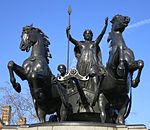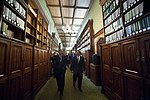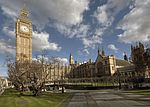Big Ben

Big Ben is the nickname for the Great Bell of the striking clock at the north end of the Palace of Westminster in London, England, and the name is frequently extended to refer also to the clock and the clock tower. The official name of the tower in which Big Ben is located was originally the Clock Tower, but it was renamed Elizabeth Tower in 2012 to mark the Diamond Jubilee of Elizabeth II. The tower was designed by Augustus Pugin in a neo-Gothic style. When completed in 1859, its clock was the largest and most accurate four-faced striking and chiming clock in the world. The tower stands 316 feet (96 m) tall, and the climb from ground level to the belfry is 334 steps. Its base is square, measuring 40 feet (12 m) on each side. Dials of the clock are 22.5 feet (6.9 m) in diameter. All four nations of the UK are represented on the tower on shields featuring a rose for England, thistle for Scotland, shamrock for Northern Ireland, and leek for Wales. On 31 May 2009, celebrations were held to mark the tower's 150th anniversary.Big Ben is the largest of the tower's five bells and weighs 13.5 long tons (13.7 tonnes; 15.1 short tons). It was the largest bell in the United Kingdom for 23 years. The origin of the bell's nickname is open to question; it may be named after Sir Benjamin Hall, who oversaw its installation, or heavyweight boxing champion Benjamin Caunt. Four quarter bells chime at 15, 30 and 45 minutes past the hour and just before Big Ben tolls on the hour. The clock uses its original Victorian mechanism, but an electric motor can be used as a backup. The tower is a British cultural icon recognised all over the world. It is one of the most prominent symbols of the United Kingdom and parliamentary democracy, and it is often used in the establishing shot of films set in London. The clock tower has been part of a Grade I listed building since 1970 and a UNESCO World Heritage Site since 1987. On 21 August 2017, a four-year schedule of renovation works began on the tower. Modifications have included adding a lift, re-glazing and repainting the clock dials, and upgrading lighting and repairing roof tiles among other improvements. With a few exceptions, such as New Year's Eve and Remembrance Sunday, the bells are to be silent until the work is completed in 2022.
Excerpt from the Wikipedia article Big Ben (License: CC BY-SA 3.0, Authors, Images).Big Ben
Officer's Corridor, City of Westminster Lambeth
Geographical coordinates (GPS) Address External links Nearby Places Show on map
Geographical coordinates (GPS)
| Latitude | Longitude |
|---|---|
| N 51.5007 ° | E -0.1245 ° |
Address
Big Ben
Officer's Corridor
SW1A 0PW City of Westminster, Lambeth
England, United Kingdom
Open on Google Maps









